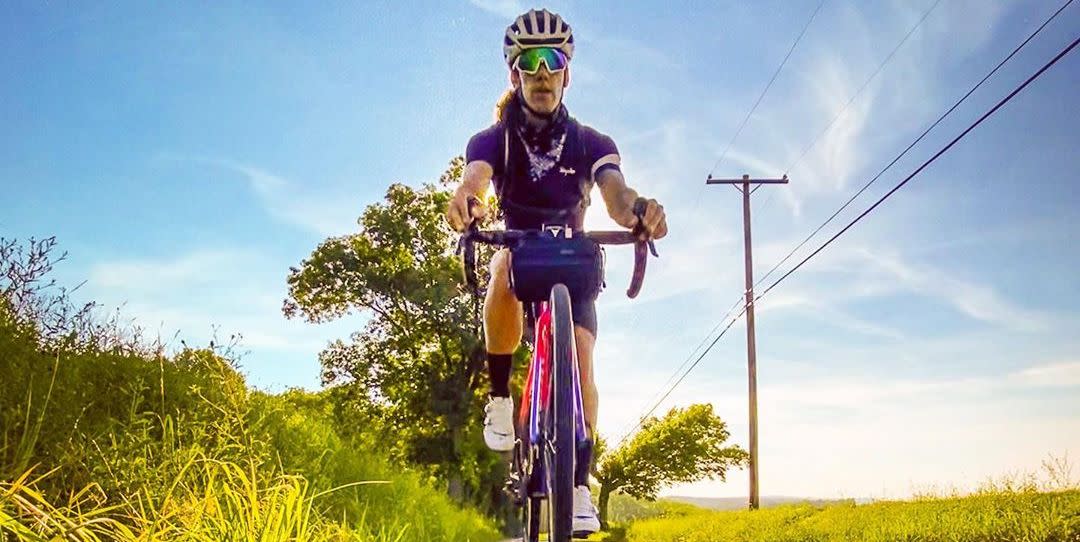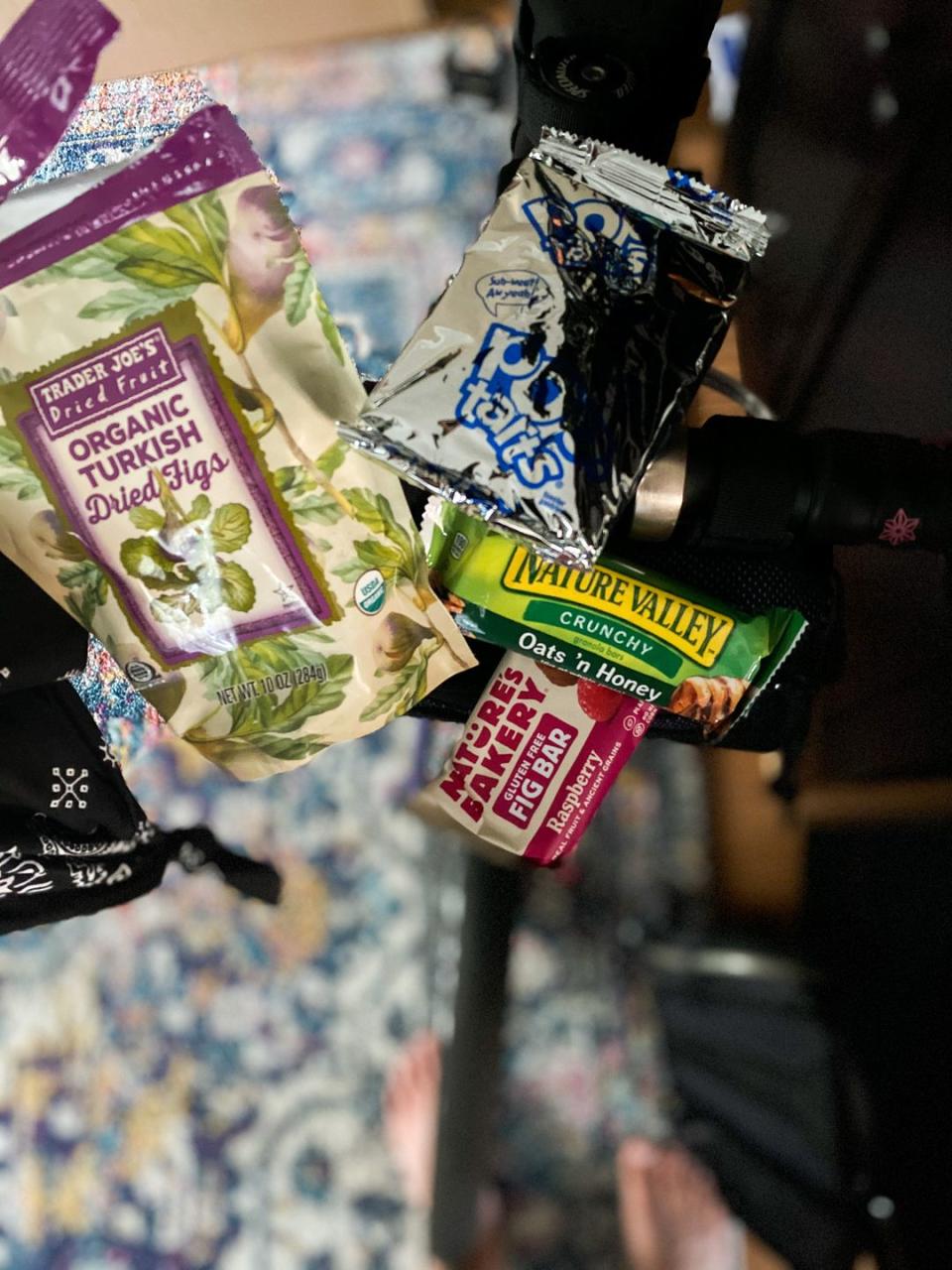This Cyclist Rode 100 Miles a Day (!) for a Month. Here’s What He Learned

What prompts someone to wake up before dawn day after day to pedal 100 miles in the middle of the summer?
For Anthony Costa, it was the memory of his dad.
When Costa’s father passed away in 2018 from a rare form of kidney cancer, he knew he wanted to do something to honor his father‘s legacy. Costa toyed with the idea of a cross-country ride but when COVID-19 made that impossible, he decided to ride a century every day in July to raise money for Leave It On the Road, a non-profit that uses cycling and storytelling to raise funds for the fight against cancer.
The 31 days of 100 miles—completed solo, because of the pandemic—passed in a blur. Some days were lighthearted and triumphant. Some days, Costa found himself stopped on the side of the road blinking back tears as he recalled the good times with his dad. Others were simply exhausting.
But as of August 12, Costa has raised $6,046 for Leave It On the Road, making the long days worth it.
Riding a century a day for a month is definitely not for everyone, but if you’re looking to embark on a challenge of your own, here’s a few things that you can learn from Costa’s experience of riding 3,100 miles in 31 days.
Set a goal that’s do-able… but barely
When it comes to picking a challenge, Costa recommends that you should feel nervous about it. That kind of stretch goal, he explains, makes the feeling of accomplishment at the end so much greater.
“If it instills doubt right before you start it, that’s good,” Costa said. “That means that it’s something worth working towards and trying to achieve. Maybe it sounds corny, but maybe it adds an element of adventure to [the challenge] if you don’t know if you’re going to make it.”
Dial in your gear
When you’re riding seven to eight hours daily, your gear from head to toe (with special considerations to the saddle area) becomes critically important.
Costa recommends setting up your bike—in his case, a 2019 Specialized S-Works Crux cyclocross bike—so that it rides efficiently and comfortably, focusing less on speed and aerodynamics. But don’t make too drastic of a change, like Costa did.
“Compared to my road bikes, I started [the challenge] with [my bike] set up a little bit more relaxed, thinking after a long day in the saddle, [sitting more upright] would be ideal,” Costa said. “But that was a huge hell no from my body the first day, and I had to drop everything down to match my road fit.”
Costa also used a OrNot barbag and saddlepack, and a Specialized Burra Burra top tube bag for easy access to his snacks and his repair tools. For water, Costa wore a Thule Uptake 4L hydration pack in order to minimize stops, both from a time and COVID19-friendly perspective.
During the month, Costa swapped between a range of Rapha kits, but looked forward to days that his pro team training jersey and bibs were fresh out of the wash. And of course, since we are in a pandemic, he never left home without a mask.
Get into a routine that includes your eating
For multiday challenges, routines can help you adjust. Costa’s days in July revolved around creating the optimal riding experience, from the time his alarm went off in the morning (around 4 a.m) to the time he went to bed at night (around 8 p.m.).
An early start helped Costa avoid some of the hottest hours of the day—and he always ate breakfast before getting on the bike. “The day starts with a big bowl of oatmeal, with a mixture of like nuts and fruits and maple syrup in there to get started,” Costa said.
“The last large meal before you start a ride like this should be lower in fat and fiber, moderate in protein, higher in carbs,” said Anne Guzman, a CISSN-certified sports nutritionist and former pro cyclist from Ontario, Canada. “Find a breakfast that works, aiming for up to 150 grams of carbohydrates. But don’t have it all in plain oatmeal, that’s a lot of fiber. I’d add maple syrup, maybe a glass of orange juice.” (Not hungry on mornings before big rides? She recommends a smoothie instead.)
Once his ride wrapped up for the day, Costa had two primary objectives: Ditch the sweaty cycling kit, and eat a recovery meal. “I try to get carbs and protein in a meal, like in an omelet with a couple slices of toast or just a peanut butter and jelly sandwich with a massive amount of peanut butter. Basic stuff.”
“In a recovery meal, 25 to 40 grams of protein that’s lower in fat is key to replenishing glycogen and starting muscle recovery,” Guzman said. “If you wait until a few hours after, there’s no way to meet all of your requirements—spread eating out as much as possible to keep fueling. And skip the big-salad-as-a-meal this month: That’s way too much fiber!”
After that, Costa focused on doing any necessary bike maintenance, and putting his feet up.
“Every once in a while, I’ll add a bath to soak my legs,” he added.

Eat plenty on the bike, too
Fuel during the ride is key for both avoiding an in-ride bonk and for setting yourself up to recover fast for the next day’s effort. Guzman recommends figuring out what fuel works best for you before you start a challenge, to avoid any GI issues, and she estimates that carbohydrate intake should be around 7-10 grams per kilogram of body weight each day during efforts like this. Additionally, she recommends eating some protein while on the bike, to help with recovery.
Costa fueled most of his rides with store-bought generic granola bars, noting that for sustained long rides not done at a hard, driving pace, finding a cheaper alternative to sport-specific gels was key. Fig bars, Nature Valley granola bars, and even the occasional PopTart kept hunger at bay during long hours in the saddle.
Hydrate, hydrate, hydrate
Since it was the middle of July, Costa focused on drinking tons of water before, during, and after his rides. Because Costa committed to not stopping at stores on his rides, he carried his water in a hydration pack and in bottles on the bike—which meant three liters of water per ride. “Sometimes, I’m going through my hydration pack and a bottle and a half, and I’m only stopping to pee twice during the ride,” he said.
“You should be going to the bathroom regularly,” Guzman said. “Hydration is so individual: it depends on sweat rate. I’d be measuring body weight before and after rides, and looking at urine—assuming you are not ingesting beet juice, asparagus, or certain vitamins—looking for a pale yellow color.”
If you struggle to take in enough fluid or eat enough on the bike, she recommends setting a timer on your phone or watch to beep every 30 minutes as a reminder to sip and chew.
It gets easier
You might think that you would be more tired by the end of the month, but Costa says the opposite has been true for him: He felt better as time went on. Maybe it’s because he dialed his food, sorted out a routine and just came to terms with the daily discomfort. Or maybe he wore his saddle in so it was more comfortable after the first few hundred miles. Perhaps it’s because after the first week, he could see the light at the end of the tunnel, and could start believing that he was going to finish.
“That first ride was the hardest,” he says. “There were moments the first day when I didn’t think I’d finish that ride, let alone the full month!” But he did, and he has. And he regrets none of it.
Come back to your why
When his dad passed away from cancer, Costa felt an overwhelming desire to take action and do something about it, for himself and for others going through similar situations.
“There were definitely a couple times where I wanted to quit, honestly,” he admitted. “But I wore my dad’s necklace the entire time, and sometimes when I got out of the saddle, I could hear the pendants kind of dangling around, and it reminds me so much of him. And I remember why I’m riding.”
You Might Also Like

